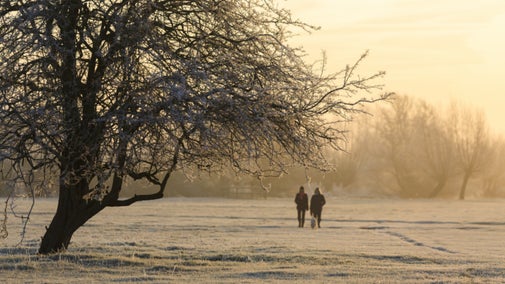Melford Hall Windmill Hill walk
Suffolk
Get away from the traffic and enjoy the simple pleasures in life. Take in the Suffolk countryside on this circular walk with hidden gems, woodland, open fields and spectacular views of Melford Hall and the church of Holy Trinity (take a peek at the stained-glass windows).
Near to
Melford HallStart point
Melford Hall, Sudbury, Suffolk CO10 9AA. Grid ref: TL866483.Trail information
*Dirt or grassy paths and fields, with stiles and some roads. May be muddy. For further details, please see Terrain section.
**Not suitable for wheelchairs/personal mobility vehicles. For further details, please see section marked Access.
***Dogs welcome but must be kept under close control. For further details, please see section marked Facilities.
More near here
Melford Hall countryside walk
Enjoy views of open fields, gently rolling hills, beautiful vistas, distant churches and clear running brooks on a walk through Suffolk countryside.

Lavenham to Long Melford railway walk
Walk amid wild flowers, birds and animals along the disused Great Eastern railway line between two medieval ‘wool’ villages, starting at the Guildhall and finishing at Melford Hall, Long Melford.

Flatford and Constable country walk
Explore the Stour Valley and Dedham Vale, captured on canvas by artist John Constable, on this relaxing walk with short and long options.

Get in touch
Our partners

We’ve partnered with Cotswold Outdoor to help everyone make the most of their time outdoors in the places we care for.
You might also be interested in
Eating at Melford Hall
The tea-room at Melford Hall in Suffolk is the ideal place to treat yourself to a cuppa and a tasty treat before, during or after your visit.

Walking in Suffolk
From strolls around famous historic sites to wanders through patchworks of purple heather, these are some of the best winter walks in Suffolk.

Walking
Explore some of the finest landscapes in our care on coastal paths, accessible trails, woodland walks and everything in between. Find the best places to walk near you.

Cotswold Outdoor: our exclusive walking partner
Learn about the National Trust’s ongoing partnership with Cotswold Outdoor. Find out how they help us care for precious places and the exclusive discount available for National Trust supporters.

Follow the Countryside Code
Help to look after National Trust places by observing a few simple guidelines during your visit and following the Countryside Code.

Staying safe at National Trust places
The special places in National Trust care sometimes come with a few risks for visitors, be it coastline or countryside. Find out how to keep safe throughout your visits.



